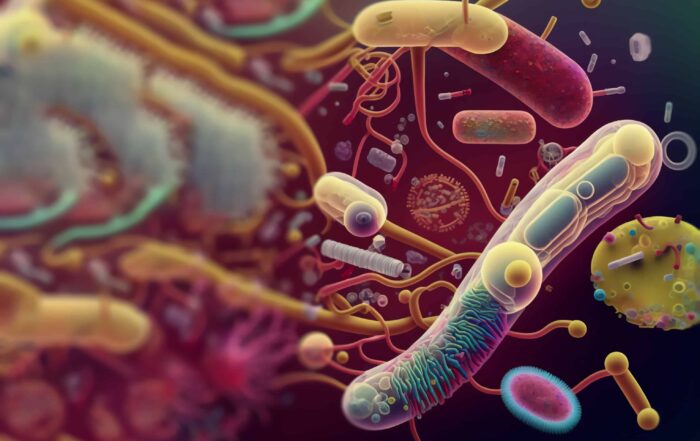Dr. Rimland’s Vision | Why an Autism History Museum? | What to Expect | Hours
Highlighting Bernard Rimland’s Vision and Contributions to the Autism Field
 To mark nearly a century of written history of autism, the Autism Research Institute (ARI) recently opened the National Autism History Museum—the first historical museum dedicated to autism. The four-room museum is located in the Kensington district in San Diego, California, adjacent to ARI’s main office.
To mark nearly a century of written history of autism, the Autism Research Institute (ARI) recently opened the National Autism History Museum—the first historical museum dedicated to autism. The four-room museum is located in the Kensington district in San Diego, California, adjacent to ARI’s main office.
Many of the materials and artifacts in the museum were collected by Dr. Bernard Rimland, one of the true pioneers in research and parent advocacy. In addition to these, the museum displays a great deal of fascinating facts, as well as timelines of important milestones in the field.
The museum describes many groundbreaking issues such as the recognition of autism by the professional community, changes in the criteria for autism since 1961, reported prevalence rates from 1966 through 2022, and the origins of behavioral therapy (or Applied Behavior Analysis).
One exhibit focuses on Dr. Temple Grandin’s efforts to help the autism community as well as to create humane ways of handling animals in livestock facilities. Another exhibit is dedicated to movies with popular actors and actresses linked to autism in some way, including Elvis Presley, Brooke Shields, Leonardo DiCaprio, and Dustin Hoffman.

ARI’s contributions to the field of autism
In honor of the opening of the new museum, this editorial will describe many of the contributions of Bernard Rimland and the Autism Research Institute during the more than 50 years since its founding. Future issues will describe other historical highlights in the autism community.
Previously, I have described how Dr. Rimland played a pivotal role in the autism field by exposing the complete lack of evidence for the then-accepted belief that autism was caused by bad parenting. Soon after his son, Mark, was diagnosed with autism, Rimland set out to do everything he could to help his son. He read every article he could find on autism and hired interpreters to translate numerous articles. Quickly, Rimland realized that the entire professional community was blaming him and his wife for emotionally neglecting Mark.
These professionals initially included Dr. Leo Kanner, an eminent scholar and well-respected child psychiatrist credited with writing the first article on autism published in a major scientific journal [1]. (To his credit, Kanner later abandoned the parent-blaming theory.) Bruno Bettelheim expanded on Kanner’s initial negative descriptions of parents, blaming them directly in his 1959 Scientific American article [2] and his 1967 book titled The Empty Fortress [3]. At that time, parents were told to attend marriage counseling sessions and have their children participate in play therapy.
Rimland began writing a paper to disprove the parental-neglect theory and to make the case that genetics, neurology, and/or the environment play an instrumental role in autism. Over a five-year period, the article grew into a book, which was published in 1964 [4]. Rimland’s thesis received immediate international acclaim and ushered in a new era of research and treatment focused on biological and behavioral interventions.
A year later, Rimland participated in a one-year think tank associated with Stanford University. During this time, he recognized the need to create a nationwide network in order to share information on effective treatments with families throughout the country. Along with Dr. Ruth Sullivan, he started the National Society for Autistic Children (NSAC), known today as the Autism Society (of America). Around this time, he visited Dr. Ivar Lovaas at UCLA, and soon afterward he instructed NSAC to share information about behavior therapy with its members.
In 1967, Rimland established the Institute for Child Behavior Research, known today as the Autism Research Institute. The aim was, and continues to be, to encourage and share scientific knowledge about understanding and supporting autistic people with researchers as well as the entire autism community.
In the late 60s and early 70s, there was an effort to establish a scientific journal dedicated to autism. At that time, the Diagnostic and Statistical Manual, version 2 (DSM-2) used the terms “autistic, atypical and withdrawn behavior” as part of the criteria for childhood schizophrenia [5]. After being approached by many scientists, Scripta Publishing Corporation in Washington, D.C. agreed to publish a quarterly journal titled the Journal of Autism and Childhood Schizophrenia. Kanner (who by then had abandoned his earlier parent-blaming views) was named as its first editor, and the editorial board included the Who’s Who in the autism field at that time. You can view an image of the cover of the first issue, the list of editorial board members, and the table of contents at www.autism.org/JACS.
When Kanner stepped down as editor in 1974, he asked Rimland to be the journal’s next editor. Because Rimland had a full-time job working as a civilian for the Navy, he declined. The editorship was then given to Eric Schopler, who held this position for the next 24 years.
In the 1980s, Rimland was an outspoken supporter of Ivar Lovaas’ work on behavior therapy, which is known today as Applied Behavior Analysis or ABA. He wrote many letters to support Lovaas’ research grants, wrote editorials promoting ABA, and lectured on its effectiveness to audiences worldwide. Through the years, ABA has evolved to become more person-centered, natural, and child-directed.
In the mid-1980s, the Hasbro toy company received much criticism for creating a GI Joe action figure described as an “extreme paranoid schizophrenic.” Soon after, Hasbro recalled the toy and donated money to support mental health research. Rimland saw an opportunity and requested a start-up grant to publish a quarterly science newsletter for parents and professionals, summarizing the current and most relevant findings on autism. ARI continues to publish this quarterly hardcopy newsletter, the Autism Research Review International.
Another major highlight in the 1980s was the release of the Academy Award-winning movie Rain Man. As many of you know, Rimland was asked to review an early draft of the script since he had published several articles on savant abilities including a popular one in a 1978 issue of Psychology Today [6]. Interestingly, Raymond was initially slated to be intellectually challenged. While giving his input on the script, Rimland suggested that Raymond have autism, even though autism was not very well known in those days. The producer took Rimland’s advice, and history was made.
During the 1990s, I began working closely with Rimland after completing graduate school and teaching for several years. During this time, we began studying sensory processing, an area of research largely inspired by Grandin’s descriptions of discomfort and even pain as a result of her sensory sensitivities. For more than a decade, we studied sensory-related treatments including auditory integration training, ambient vision therapy, and Grandin’s Hug Machine.
Since Rimland’s passing in 2006, ARI continues to maintain many of the programs he started. As a continuation of his vision, we currently fund many more biologically based research studies. In addition, we have expanded our efforts to include understanding and supporting adults and seniors on the spectrum. We also sponsor numerous free webinars on co-occurring medical issues for the autism community worldwide (for information, visit autism.org), and we disseminate science-based information through monthly and bimonthly e-newsletters.
As one would expect, the autism field has progressed quite significantly since Rimland’s initial insights nearly 60 years ago. For example, the publication of the DSM-5 a decade ago made autism a more inclusive diagnosis by integrating those diagnosed with Asperger syndrome and Pervasive Developmental Disorder (or PDD) [7]. More recently, autistic individuals are sharing their voices and becoming active participants in the direction of research as well as co-producing this research.
Come and visit us!
ARI’s history is just one of the topics explored in the rich collection of documents and artifacts in the National Autism History Museum. If you are traveling to San Diego for business or pleasure, I hope you will have a chance to stop by the museum, where you can learn about the past—because understanding the past can help us create a framework for the future.
Stephen M. Edelson, Ph.D.
Executive Director, Autism Research Institute
Read Part 2 – Why an Autism History Museum?
References are available at www.ARRIReferences.org.
This editorial originally appeared in Autism Research Review International, Vol. 37, No. 1, 2023
Editorial – Fecal Microbiota Transplantation and Autism
Over the past several years, Fecal Microbiota Transplantation (FMT) has become the subject of growing interest in the autism community due, at least in part, to the increased awareness of the gut-brain
ARI’s Latest Accomplishments
Connecting investigators, professionals, parents, and autistic people worldwide is essential for effective advocacy. Throughout 2023, we continued our work offering focus on education while funding and support research on genetics, neurology, co-occurring medical
Biomarkers start telling us a story: Autism pathophysiology revisited
Antonio Persico, MD, a recent ARI Research Grant recipient, explores the role of biomarkers in understanding autism pathophysiology. He discusses the complexity inherent to neurodevelopmental conditions and emphasizes the need to combine




